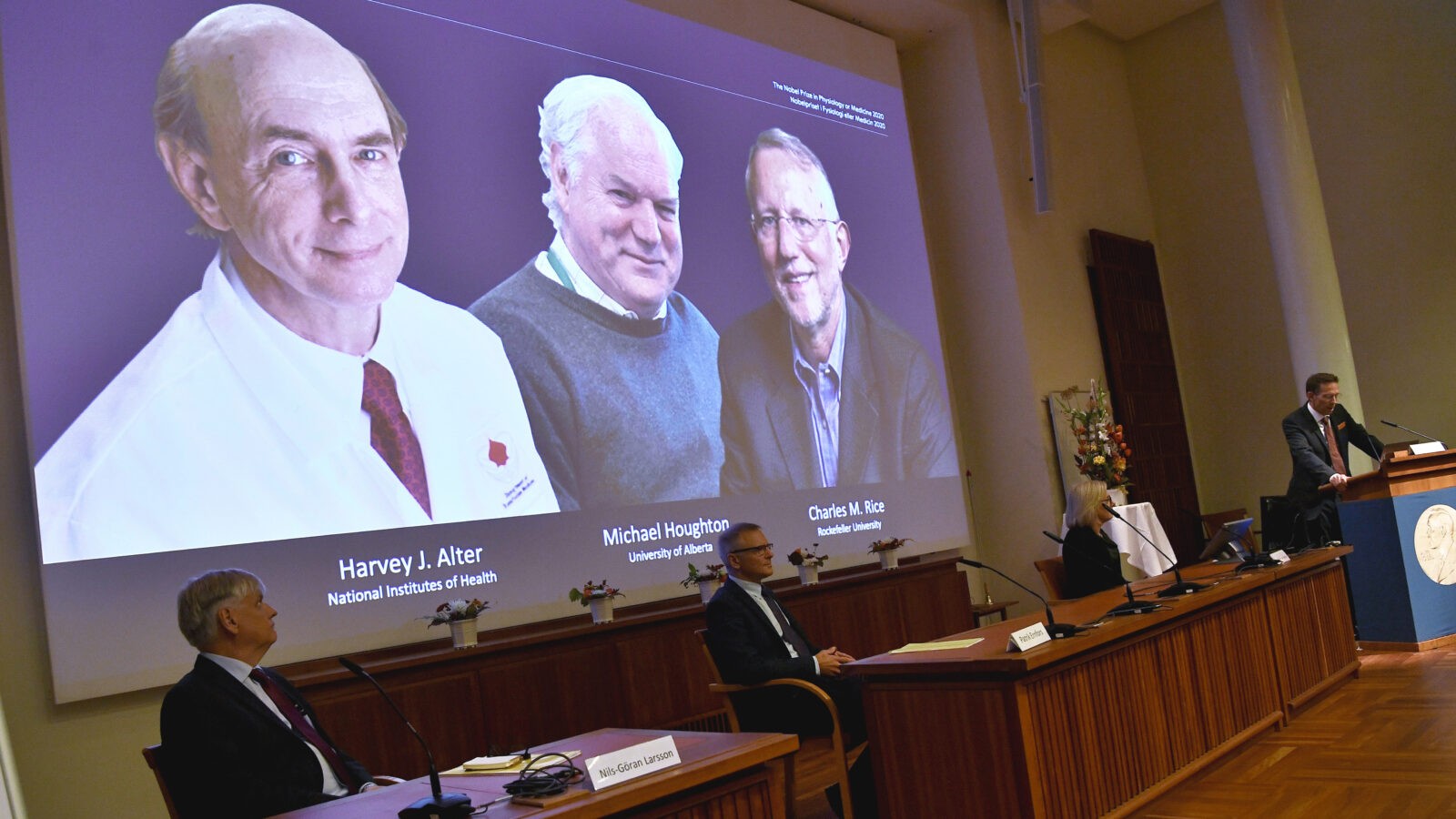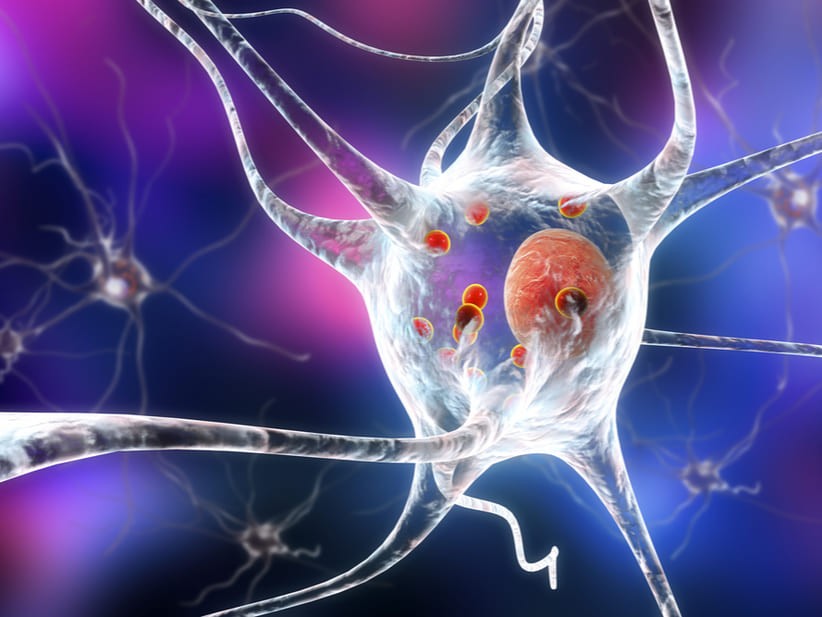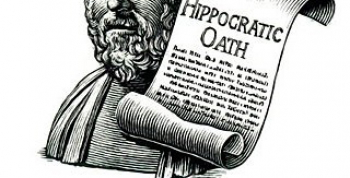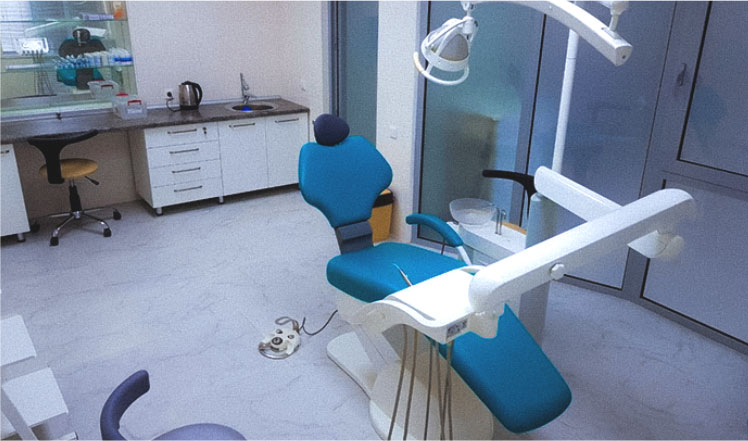Trio wins Nobel Prize in medicine for discovery of hepatitis C virus

Thomas Perlmann (far right), secretary of the Nobel Assembly, announces the 2020 Nobel laureates in physiology or medicine during a news conference at the Karolinska Institute in Stockholm, Sweden, Monday. The prize has been awarded jointly to (from left on screen) Harvey Alter, Michael Houghton, and Charles Rice for the discovery of the hepatitis C virus.CLAUDIO BRESCIANI/TT VIA AP
Two Americans and one British-born scientist now working in Canada have won the 2020 Nobel Prize in medicine or physiology on Monday for their discovery of the hepatitis C virus. Thomas Perlmann, secretary of the Nobel Committee and professor of molecular development biology at the Karolinska Institute, announced the award at a ceremony in Stockholm. Harvey Alter of the National Institutes of Health in Bethesda, Md., Michael Houghton the University of Alberta in Canada, and Charles Rice of Rockefeller University in New York City share the prize. Their work has helped speed the fight against blood-borne hepatitis, a major global health problem that causes cirrhosis and liver cancer in people around the world. Their discovery has also allowed for the rapid development of antiviral drugs directed at hepatitis C. “The discovery of hepatitis C virus was important for public health in two ways,” biochemist Jeremy Berg, professor of computational and systems biology at the University at Pittsburgh and former director of the NIH’s National Institute of General Medical Sciences, told STAT. “First, the discovery enabled testing for screening blood for the agent that was responsible for blood-borne transmission of hepatitis and liver cancer risk. Second, knowledge of the causative agent facilitated drug development, particularly protease inhibitors that can treat existing hepatitis C virus infections and cure the disease in many cases.” “Thanks to their discovery, highly sensitive blood tests for the virus are now available and these have essentially eliminated post-transfusion hepatitis in many parts of the world, greatly improving global health,” the Nobel Prize committee said in its announcement. “For the first time in history, the disease can now be cured, raising hopes of eradicating Hepatitis C virus from the world population.” The three laureates will share 10 million Swedish kronor, or about $1.07 million. Their names are added to a list of medicine Nobel winners that includes 222 men and 12 women. Hepatitis, defined as liver inflammation, is usually caused by a viral infection, although alcohol misuse, environmental toxins, and autoimmune disease can also lead to the same condition. Hepatitis A comes from contaminated food or polluted water, but the illness it causes is relatively brief in duration. Hepatitis C, like hepatitis B, is a blood-borne infection, bringing acute illness to some people but chronic disease to 71 million people around the world, according to WHO estimates. This is the second Nobel Prize awarded for a hepatitis discovery. In the 1960s, Baruch Blumberg, who identified what became known as the blood-borne hepatitis B virus, won the prize in 1976. Baruch laid the groundwork for the development of diagnostic tests and an effective vaccine. Alter had also been studying hepatitis in patients who had received blood transfusions. Tests based on Baruch’s work could diagnose transfusion-related hepatitis B, but they still couldn’t explain a large number of cases. Tests for hepatitis A virus infection were also developed around this time, but could not account for these cases. Alter and his NIH colleagues proved that this was something different when they showed that blood from these hepatitis patients could transmit the disease to chimpanzees, the only susceptible host besides humans. Later studies determined that this infectious agent was indeed a virus and the disease was a new, distinct form of chronic viral hepatitis that became known as “non-A, non-B” hepatitis. Michael Houghton, then working for the pharmaceutical firm Chiron, took the next steps to isolate the genetic sequence of the virus. That meant collecting DNA fragments from nucleic acids found in the blood of an infected chimpanzee, on the theory that they would contain some genetic material from the unknown virus. Houghton and his team used sera from hepatitis patients to identify the virus — based on their suspicion that the patients’ blood would contain antibodies to the virus. They did find one clone and later showed that it was derived from a novel RNA virus belonging to the flavivirus family and it was named hepatitis C virus. The antibodies in chronic hepatitis patients were the smoking gun pointing toward this virus as the missing agent. Rice, while a researcher at Washington University in St. Louis, then worked to answer an essential question: Could this clone alone cause hepatitis C? Rice and other groups had zeroed in on one end of the cloned viral genome that hadn’t been characterized. There were some variations that made it difficult for the virus to replicate, so he genetically engineered an RNA variant of hepatitis C virus that included the newly defined region of the viral genome and subtracted the inactivating genetic variations. When this RNA was injected into the liver of chimpanzees, virus was detected in the blood, as were the kind of pathological changes seen in humans with the chronic disease. This was the final proof that hepatitis C virus alone could cause the unexplained cases of transfusion-mediated hepatitis. Rice was previously honored for his studies of hepatitis C replication with the 2016 Lasker Award, often called a precursor to the Nobel. He shared that prize with Ralf Bartenschlager of the University of Heidelberg and Michael Sofia, formerly at Pharmasset and now at Arbutus Biopharma. And Alter and Houghton shared an earlier Lasker Award, in 2000, for their hepatitis C work, furthering the Lasker’s reputation as a Nobel predictor. The prize recognized Alter’s work identifying “non-A, non-B hepatitis” and Houghton’s use of then-early molecular biology methods to isolate the virus. In 2013, Houghton turned down $100,000 in prize money from the Gairdner Foundation for a prize recognizing the same work because it did not include two colleagues: Qui-Lim Choo and George Kuo, who worked with him at Chiron when they identified and cloned the hepatitis C virus. “I agonized over it,” Houghton told The Globe and Mail of accepting another prize in which his colleagues were not named. “And I decided I didn’t want to do that again.” “The three of us worked closely together for almost seven years to discover this very elusive and challenging virus using a novel approach in the field of infectious disease,” he told the Canadian Press at the time of the Gairdner prize. The Canadian award is also considered a Nobel bellwether. In a conference call with reporters Monday morning, Houghton said he would accept the Nobel Prize and his share of the money. “It would be really too presumptuous of me to turn down a Nobel,” he said, citing the Nobel’s traditions and regulations drawn from the will of its creator, Alfred Nobel. “Most big inventions, not all of them, but most involve many people, and I worked for six or seven years with two colleagues at Chiron Corp. in California, and without their input I doubt I would have succeeded.” This story has been updated with detail on the laureates’ research. Sharon Begley contributed to this report. Elizabeth Cooney




